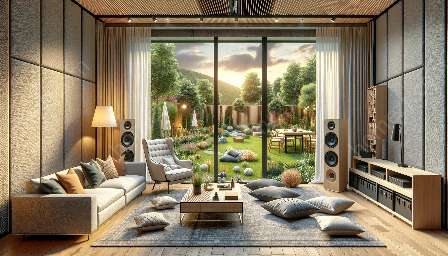Sound plays a crucial role in our lives, especially within the spaces we inhabit. The way sound behaves within a room has a profound impact on our overall experience and comfort. In this comprehensive guide, we will delve into the fascinating world of room acoustics, focusing specifically on sound reflection, refraction, and diffusion, and their implications on indoor noise levels and noise control in homes.
Sound Reflection in Room Acoustics
When sound encounters a surface, it can be reflected, absorbed, or transmitted. In room acoustics, sound reflection occurs when the waves hit a surface and bounce off, potentially reaching the listener's ears after a delay due to the longer path traveled. This can lead to the formation of echoes and reverberation, which can impact the clarity of sound and the overall acoustic quality of the space.
Architectural elements such as walls, floors, and ceilings can influence sound reflection. Smooth, hard surfaces tend to reflect sound more effectively, while softer, uneven surfaces can absorb or diffuse sound, affecting the overall acoustics of the room. Understanding and controlling sound reflection in a space is critical for achieving optimal acoustics and minimizing disruptive noise levels.
Sound Refraction in Room Acoustics
Refraction refers to the bending of sound waves as they travel through different mediums or when encountering changes in temperature, humidity, or air density. In room acoustics, refraction can occur when sound waves pass through openings, such as doors, windows, or vents, leading to changes in the direction and intensity of sound.
Proper design and placement of openings in a room can help manage sound refraction, reducing the potential for sound disturbances and maintaining a balanced acoustic environment. Additionally, understanding the principles of sound refraction is crucial when addressing the impact of room acoustics on indoor noise levels, as it directly influences the propagation and distribution of sound within a space.
Sound Diffusion in Room Acoustics
Diffusion involves the scattering of sound waves in different directions, reducing the formation of strong reflections and standing waves. By utilizing diffusive surfaces and structures within a room, such as irregularly shaped panels, acoustic diffusers, or strategically positioned furnishings, sound diffusion can help create a more balanced and natural acoustic environment.
By promoting a controlled scattering of sound, diffusion contributes to a more uniform distribution of sound energy, minimizing the concentration of sound in specific areas and reducing the potential for noise build-up and disturbances. Understanding and implementing sound diffusion techniques are essential when addressing noise control in homes, as they can significantly enhance the overall acoustic comfort and quality of the living space.
Impact of Room Acoustics on Indoor Noise Levels
Room acoustics play a pivotal role in shaping the indoor sound environment, directly influencing the levels and characteristics of noise within a given space. When sound reflection, refraction, and diffusion are carefully managed and optimized, they can contribute to a balanced and comfortable acoustic experience, reducing the impact of unwanted noise and promoting a more harmonious living environment.
However, neglecting the principles of room acoustics can lead to undesirable consequences, such as excessive reverberation, uneven sound distribution, and increased noise levels within a room. Understanding the interplay between room acoustics and indoor noise levels is essential for creating environments that are conducive to relaxation, productivity, and overall well-being.
Noise Control in Homes
Addressing noise control in homes requires a holistic approach that encompasses architectural design, material selection, and strategic spatial planning. By integrating principles of room acoustics and sound management into the residential environment, homeowners can create spaces that are conducive to tranquility and auditory comfort.
Strategies for noise control in homes may include the implementation of sound-absorbing materials, the strategic placement of furnishings to promote sound diffusion, and the consideration of window and door designs that minimize sound transmission. Additionally, utilizing technologies such as sound masking systems or active noise control solutions can further enhance the acoustic quality of residential spaces, contributing to a more peaceful and serene living environment.
By understanding the complexities of sound reflection, refraction, and diffusion in room acoustics and their implications on indoor noise levels, homeowners can make informed decisions that lead to enhanced comfort, reduced disturbances, and an overall improvement in the quality of their living spaces.


